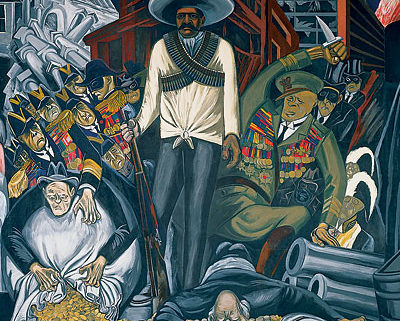José Clemente Orozco, Mural Artist
The rich, complex murals of artist José Clemente Orozco grace the walls of respected institutions throughout the Americas. Orozco was born in Jalisco, Mexico, on November 23, 1883. Orozco faced numerous hardships in his passionate pursuit of art. A gunpowder explosion in his youth destroyed part of his left hand and wrist, and partially blinded him. While establishing himself as an artist, he endured financial difficulties and misunderstanding. In 1917, when he traveled to North America for the first time, the US Customs Service seized his work as indecent – his wrenching, realistic scenes of war, injustice, tyranny, and desperation were ahead of their time. Orozco achieved recognition later in his life. One of his most famous works is in New Hampshire, in Dartmouth College’s Baker Memorial Library. He painted “The Epic of American Civilization” while at Dartmouth from 1932 to 1934. The mural covers 3,200 square feet and displays the history of the Americas from the migration of the Aztecs into central Mexico to the development of modern industrialized society.
Los ricos y complejos murales del artista José Clemente Orozco adornan las paredes de instituciones respetadas en todo el continente americano. Orozco nació en Jalisco, México, el 23 de noviembre de 1883. Orozco enfrentó numerosas dificultades en su apasionada búsqueda del arte. Una explosión de pólvora en su juventud destruyó parte de su mano y muñeca izquierda y lo cegó parcialmente. Mientras se establecía como artista, soportó dificultades financieras y malentendidos. En 1917, cuando viajó a América del Norte por primera vez, el Servicio de Aduanas de Estados Unidos consideró su trabajo indecente: sus escenas desgarradoras y realistas de guerra, injusticia, tiranía y desesperación se adelantaron a su tiempo. Orozco logró el reconocimiento más adelante en su vida. Una de sus obras más famosas está en New Hampshire, en la Baker Memorial Library de Dartmouth College. Pintó “ La epopeya de la civilización estadounidense” mientras estuvo en Dartmouth de 1932 a 1934. El mural cubre 3200 pies cuadrados y muestra la historia de las Américas desde la migración de los aztecas al centro de México hasta el desarrollo de sociedad industrializada moderna.





Leave a Reply
Want to join the discussion?Feel free to contribute!